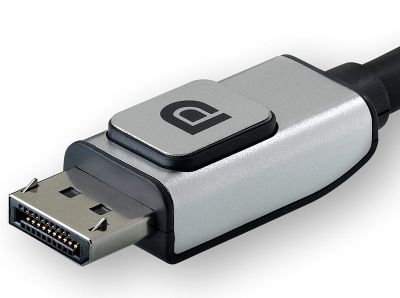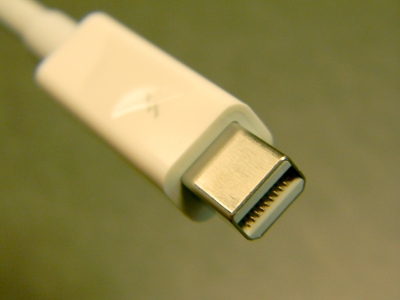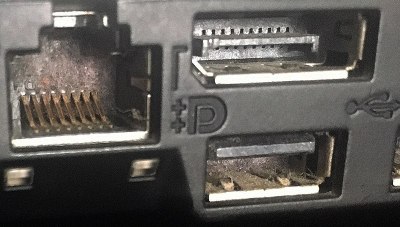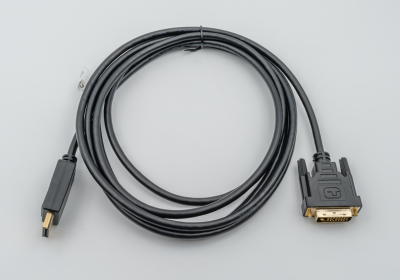Over the years, we’ve seen a good number of interfaces used for computer monitors, TVs, LCD panels and other all-things-display purposes. We’ve lived through VGA and the large variety of analog interfaces that preceded it, then DVI, HDMI, and at some point, we’ve started getting devices with DisplayPort support. So you might think it’s more of the same. However, I’d like to tell you that you probably should pay more attention to DisplayPort – it’s an interface powerful in a way that we haven’t seen before.

You could put it this way – DisplayPort has all the capabilities of interfaces like HDMI, but implemented in a better way, without legacy cruft, and with a number of features that take advantage of the DisplayPort’s sturdier architecture. As a result of this, DisplayPort isn’t just in external monitors, but also laptop internal displays, USB-C port display support, docking stations, and Thunderbolt of all flavors. If you own a display-capable docking station for your laptop, be it classic style multi-pin dock or USB-C, DisplayPort is highly likely to be involved, and even your smartphone might just support DisplayPort over USB-C these days.
Video Done Right
Just like most digital interfaces nowadays, DisplayPort sends its data in packets. This might sound like a reasonable expectation, but none of the other popular video-carrying interfaces use packets in a traditional sense – VGA, DVI, HDMI and laptop panel LVDS all work with a a stream of pixels at a certain clock rate. HDMI is way more similar to VGA than it is to DP. With DisplayPort, the video is treated like any regular packetized data stream, making the interface all that much more flexible! Physically, desktop/laptop DisplayPort outputs come in two flavors – full-size DisplayPort, known for its latches that keep the cable in no matter what, and miniDisplayPort, which one would often encounter on MacBooks, ThinkPads, and port-space-constrained GPUs.

However, if you don’t need the full bandwidth that four lanes can give you, a DP link can consist of only one or two main lanes resulting in two and three diffpairs respectively, with less bandwidth but also less wiring. This is perfect for laptop and embedded applications, where DisplayPort has taken hold, and certainly beats HDMI’s “four diffpairs at all costs” requirement. The advantages don’t end here, but I’d like to note that DisplayPort is also way more hackable – of course, I’ll show you!
For more advantages, the DisplayPort sideband channel, AUX, is a great improvement over I2C, which we’ve been using as a sideband interface for VGA and HDMI. It’s a lower-speed bidirectional single-diffpair link that doesn’t just bring backwards compatibility with EDID (display identification) and DDC (display control), but is also used for DisplayPort link training communications, as well as gives developers control over a number of low-level aspects from the DP transmitter side. Audio travels over AUX too, and it’s future-proof – for instance, features like CEC can be implemented over the AUX layer, instead of the single-wire kludge that is HDMI CEC.
All of these aspects have resulted in an interface that’s pretty friendly for modern-day tech. Thunderbolt has coexisted with DisplayPort in particular – TB1 and TB2 have been using miniDisplayPort connectors that you might’ve encountered on Apple laptops, bearing the lightning bolt symbol. When it comes to TB3 and TB4, those coexist with DisplayPort on USB-C connectors, and DisplayPort is a first-class guest in the Thunderbolt ecosystem, with DisplayPort tunneling being an omnipresent feature in Thunderbolt peripherals.

Embrace, Extend, Embed
DisplayPort isn’t just for consumer-use monitors, however – remember the flexibility about number of lanes? This alone is a big win for DisplayPort when it comes to internal connectivity, and, considering the sheer number of features already making it embedding-friendly and low-power, the embedded DisplayPort standard (eDP) was developed, compatible with DP in almost every aspect. If you have a laptop or an iPad, it’s highly likely to be using eDP under the hood – in fact, the first time we mentioned eDP over on Hackaday, was when someone reused high-res iPad displays by making a passthrough breakout board with a desktop eDP socket. Yes, with DisplayPort, it’s this easy to reuse laptop and tablet displays – no converter chips, no bulky adapters, at most you will need a backlight driver.
eDP came in handy right as we started pushing against the limits of FPD-Link, which you might have heard called LVDS in the laptop panel space. Ever since mid-2010s, you’ll be hard pressed to find any newly designed laptop that still has an LVDS panel, and nowadays it’s all eDP. The advantage is noticeable – what LVDS needs six or eight diffpairs for, eDP can do with two or three, letting designers use cheaper wiring and freeing up PCB space, and enabling extremely high resolution displays with just four pairs. Unlike classic LVDS implementation laptops which aren’t required to use I2C for EDID purposes, the AUX channel provides EDID for free – which also might mean that your laptop might just work if you are to plug in a display with a higher or lower than factory resolution; something that isn’t a guarantee with LVDS.
Oh, and all this flexibility didn’t just help with laptop displays – it also made DisplayPort a perfect match for the video backbone of USB-C, to the point where, if you see a USB-C dock with any kind of video output connector, you can basically be sure that the video output capability is powered by DisplayPort. We will talk more later about the DisplayPort altmode in way more depth in the next weeks. Until then, I’ll note that all those strengths of DisplayPort, undoubtedly, contributed to the HDMI altmode dying out – especially the ability to run an extra USB3 link alongside DisplayPort through the same USB-C cable. I’d like to assure you, however, that the HDMI altmode dying out is a win for us all.
Plus, It’s Not HDMI
Another large advantage of DisplayPort is that it’s not HDMI. We’ve all gotten used to HDMI, but if you’ve been lurking in related tech discussions, you’ll know that HDMI has got a few nasty aspects to it. The reason is fundamental – HDMI is backed by media interests vested in things like home theater and TV, as opposed to the personal computing field where the VESA group comes from. The HDMI group claims to value interoperability when, say, protesting against the sale of certain products, but the recent HDMI 2.1 debacle has shown us that it isn’t truly a focus of theirs. My observation so far has been that the HDMI group is averse to competition, marketing and branding considerations are significant driving forces in their decisionmaking, and so is extracting per-device royalties from manufacturers – steep for players small and large alike. Bringing a good product appears to be secondary.
Neither DP nor HDMI standards are openly available – however, HDMI is restricted way more NDA-wise, to the point where AMD is unable to implement features like FreeSync and higher resolutions in their open-source Linux drivers specifically in HDMI; DisplayPort isn’t burdened to such an extent. When it comes to devices we buy, especially from a hacker viewpoint, certain HDMI certification requirements may bring us worse products when they’re included. A carefully shaped money-backed lever over the market is absolutely part of reason you never see DisplayPort inputs on consumer TVs, where HDMI group reigns supreme, even if the TV might use DisplayPort internally for the display panel connection.
Oh, and given all these, it should be no surprise to read that HDMI isn’t hacker-friendly either – the HDMI group is known to strongarm chip manufacturers into requiring HDMI IC and devboard buyers to cough up the HDMI adopter fee first – if you’re not in the club, you don’t even get to play with a devboard. Sure, the Raspberry Pi CM4 might have two HDMI links exposed, but if you aren’t careful while marketing your board or the product it goes in, you’re in legal limbo at best – DisplayPort has no such issue. That cool $10 open-source HDMI capture card we covered a few months ago? If you want to manufacture and sell them, you better talk to a competent lawyer first, and lawyers savvy in HDMI licensing issues aren’t quite commonplace – putting this idea out of reach for a hobbyist who just wants to order a few open-source boards and sell them to others.

The Shapeshifting Interface
When it comes to DisplayPort connectors on our GPUs and laptops, there’s an even cooler thing you can do – switch it into HDMI compatibility mode, a feature called DP++. All you need is a dongle that has a logic level shifter inside so that the signals are re-shaped as needed, presents those signals on a HDMI connector, and shorts two pins on the DisplayPort connector, signaling the GPU to do a mode switch. Oh, and if you’re wondering how AUX could be compatible with I2C in case of DP++ – the GPU puts an I2C bus on the AUX pins instead. We buy these dongles as DisplayPort to HDMI converters, but in reality, the dongle doesn’t do much on its own, mostly telling the GPU to start outputting HDMI – it’s cheap, efficient and has low power consumption as a side effect.

As you might see now, DisplayPort is a friendly interface, perhaps way friendlier than you might have expected! Since its introduction, Intel and AMD have made big bets on DisplayPort – and now, it’s basically a staple of portable devices, even if you don’t see a DisplayPort connector on the outside. Not even talking about eDP or the DP altmode – nowadays, even for a typical HDMI connector on your modern-day laptop, the backbone is DP, or a lower-level interface like Intel and AMD’s DDI interfaces tailored towards producing DP first and foremost, with HDMI being a bit of a second-class citizen. After all, DisplayPort has enough advantages to deserve such first-class treatment.
Now, these are mostly consumer-facing benefits of DisplayPort, but I hope that they can give you insights on what makes modern DisplayPort tick. Next time, I’d like to show you all the new things that a hacker can get out of DisplayPort – more in-depth about eDP aka embedded DisplayPort, a bit of insight into the AUX channel, designing our own PCBs with DisplayPort links, and some of the intricacies of cabling.
"interface" - Google News
July 11, 2023 at 09:00PM
https://ift.tt/Cme2AiO
DisplayPort: A Better Video Interface - Hackaday
"interface" - Google News
https://ift.tt/A6BxYcd
https://ift.tt/03cjWdT
Bagikan Berita Ini














0 Response to "DisplayPort: A Better Video Interface - Hackaday"
Post a Comment